February 13 Inland Train Journey (Day 139)
Our first full day in Dunedi. Actually, we are staying about 8km outside of Dunedin, in St. Leonard, a tiny community of houses on the road skirting the north side of Otago Harbour towards Port Chalmers. Port Chalmers sits about half way into Otago (oh-tah-go) Harbour and is a major port in NZ. It was the site where the first load of frozen meat (lamb & mutton I assume) left for London in a refrigerated ship, in 1882! This started the main export trade of meat which now includes exporting raw logs, and also now includes berths for huge cruise ships! Dunedin city proper sits at the inland end of the harbour. Our adventure today however takes us further inland, into the rural areas where the meat and timber is raised, on the farms of the Central Otago District. The Inlander Scenic Train trip is a sporadically scheduled trip on the old Central Otago Rail line that was built in the late 1800’s. Reaching deep into the rural ‘wop-wops’ (backcountry/middle of nowhere), it was a vital link for the farmers to get their stock to market. Departure was scheduled for 10am, but we arrived just after 9am to view the amazing Dunedin Railway Station!

Claiming to be the second most photographed building in the southern hemisphere! Surpassed only by the Sydney, Australia Opera House!
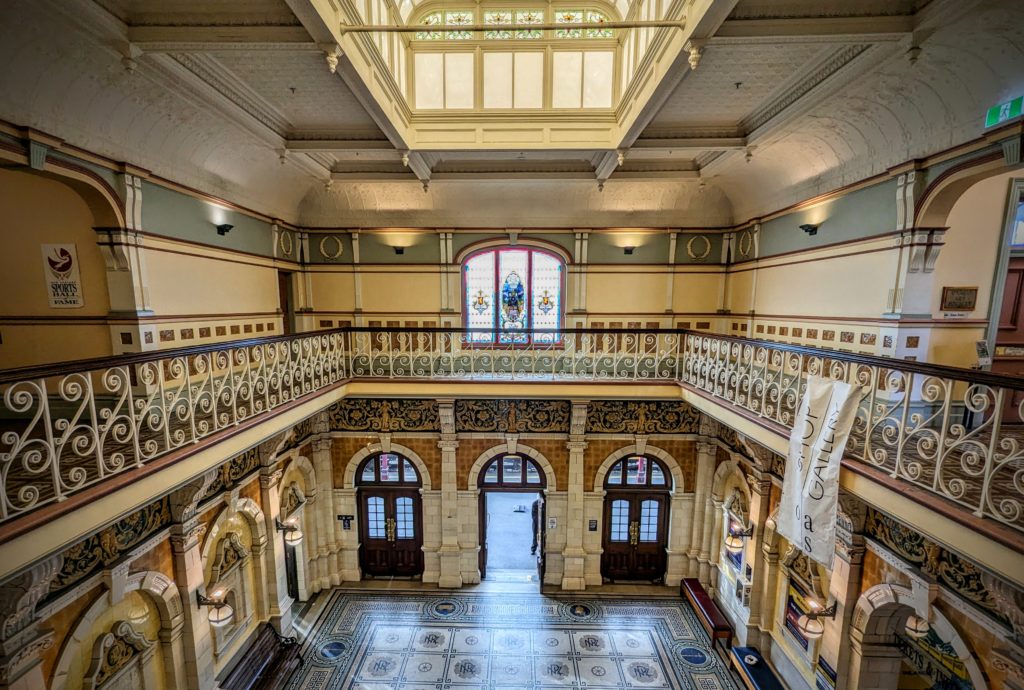
The Victorian era was coming to a close when the station was opened in 1906 and it is filled with impressive tileworks, fabulous mosaics, some stained glass and wrought iron decoration!
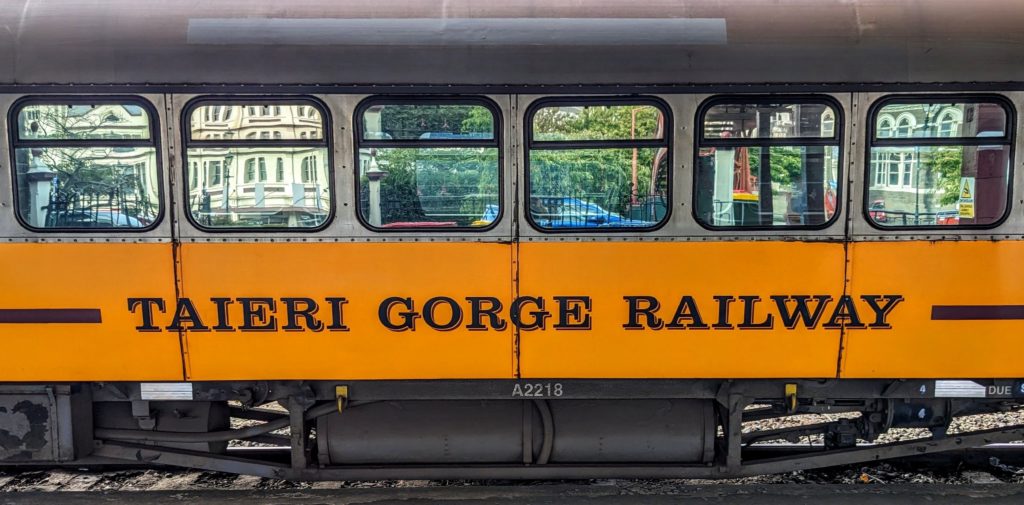
As the rail era ended with the prominence of automobiles and highways, in 1990 the railway moved into private hands as The Taieri Gorge Railway, then the Dunedin Railway, operating as a scenic route. Maintenance costs further reduced the line to one-third of it’s original length, with the other two-thirds either submerged under a man-made lake or removed to become the Otago Central Rail Trail.
The Inlander now travels from the Dunedin Railway Station through the Taieri gorge, carved by the Taieri river, to the tiny stop at Hindon, site of an old gold mining town of the 1860’s. Parts of the gorge are inaccessible by any other means except bush-whacking, there aren’t even trails through it! Before Covid the railway would take fishermen into the gorge, let them off the train to hike and fish stretches of the river, then pick them up at a later date at a specified stop!
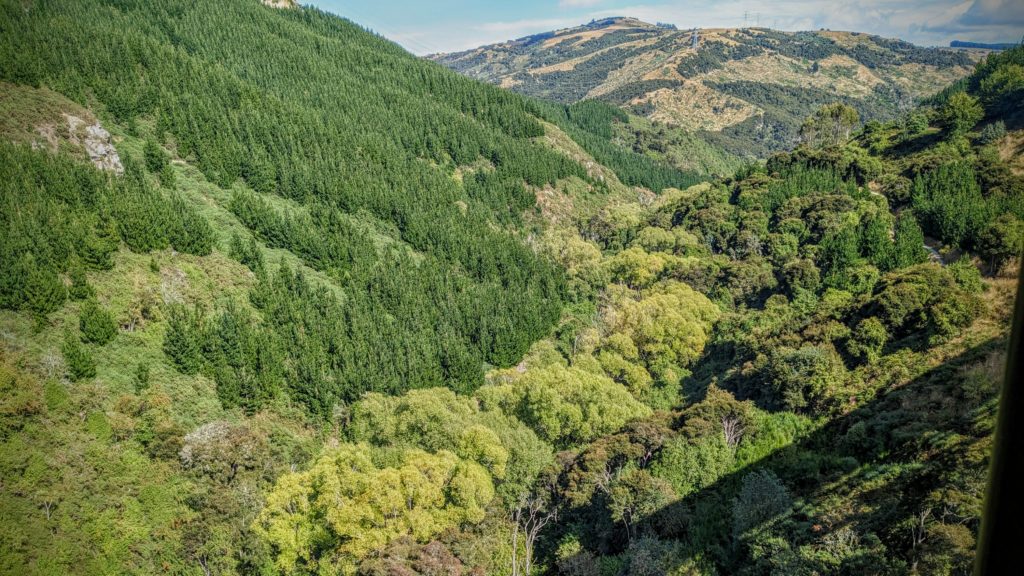
The shadow of the train crossing a bridge over the Taieri river. Native bush on the right and along the river bed. Introduced pine on the hill on the left. Clear cut pine plantations in the background.
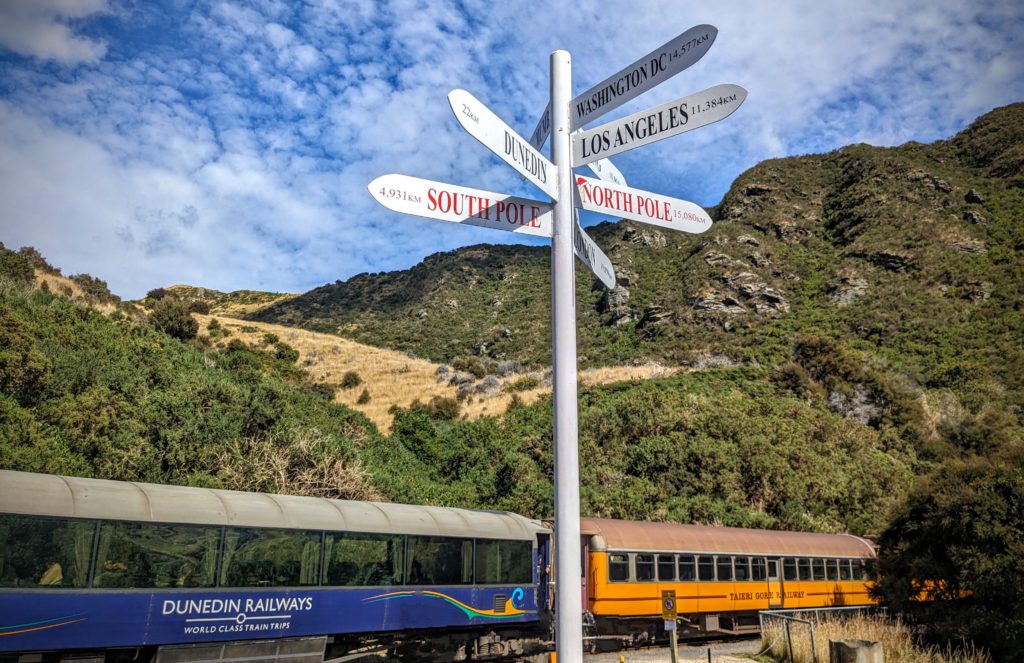
The stop at Hindon is surrounded by rimrock and soaring harrier hawks. We had time to walk around, read some history of the area and get a glass of wine before we headed back towards Dunedin.
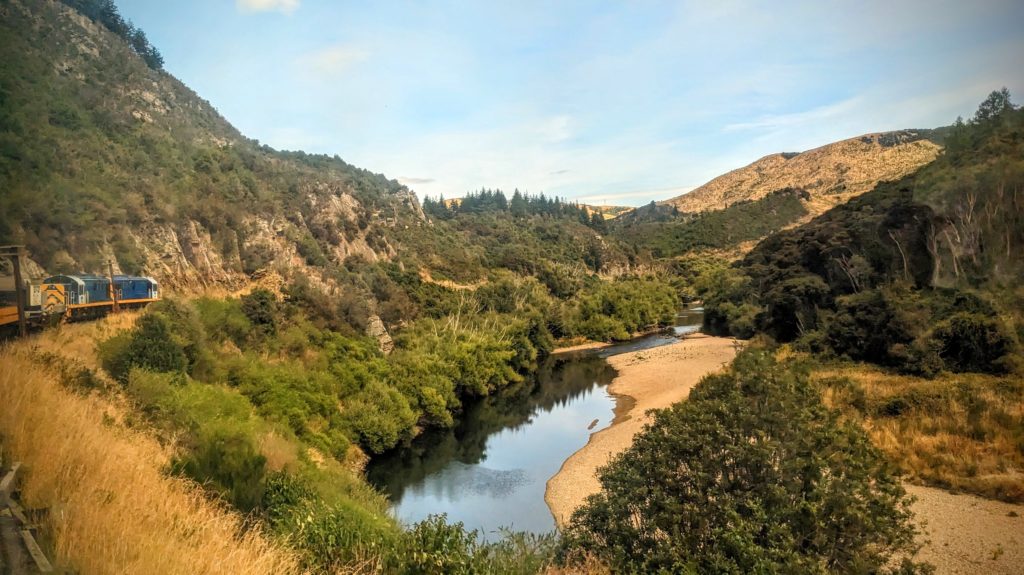
The river is low this summer, but the commentary spoke of several past floods that filled the gorge up to the tracks!

We passed the old stop at Parera that is now a private residence, accessed only by walking through a railway tunnel!
It was a fun ride through interesting terrain, crossing many bridges (‘viaducts’ here in NZ) including the Wingatui Viaduct, “the largest wrought iron structure in New Zealand since it was built in 1887” (per wikipedia), and through many tunnels which were dug by hand in the late 1880’s!
February 12 To Dunedin (Day 138)
After breakfast this morning we met John & Martha at their hotel and went back to the Kiwi Park for a 10am “Kiwi Encounter“. The half hour presentation takes place in the darkened Kiwi House where the day/night cycle is switched so that the kiwi are awake and active during our daytime. That makes it hard to see the kiwi until your eyes adjust, which takes about half an hour! It was amazing, we never realized that kiwi are that active and that they are that big! The females are about the size of a small chicken, the males smaller. Photography is not allowed, so no pictures. After our encounter we crossed the road to the Gondola and took a ride up Bob’s Peak for spectacular views!
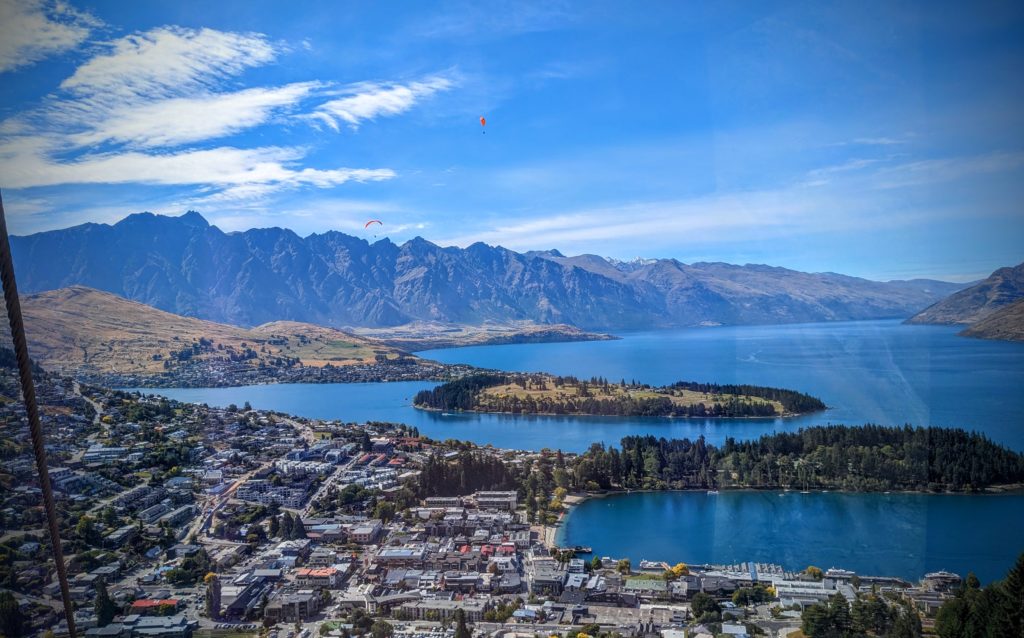
As we rose up the steepest cable car lift in the Southern Hemisphere the jagged Remarkables mountain range came into view in the distance. A few paragliders float over town and the waterfront beach is visible. The closest peninsula is the Queenstown Gardens, while the further one has a golf course.
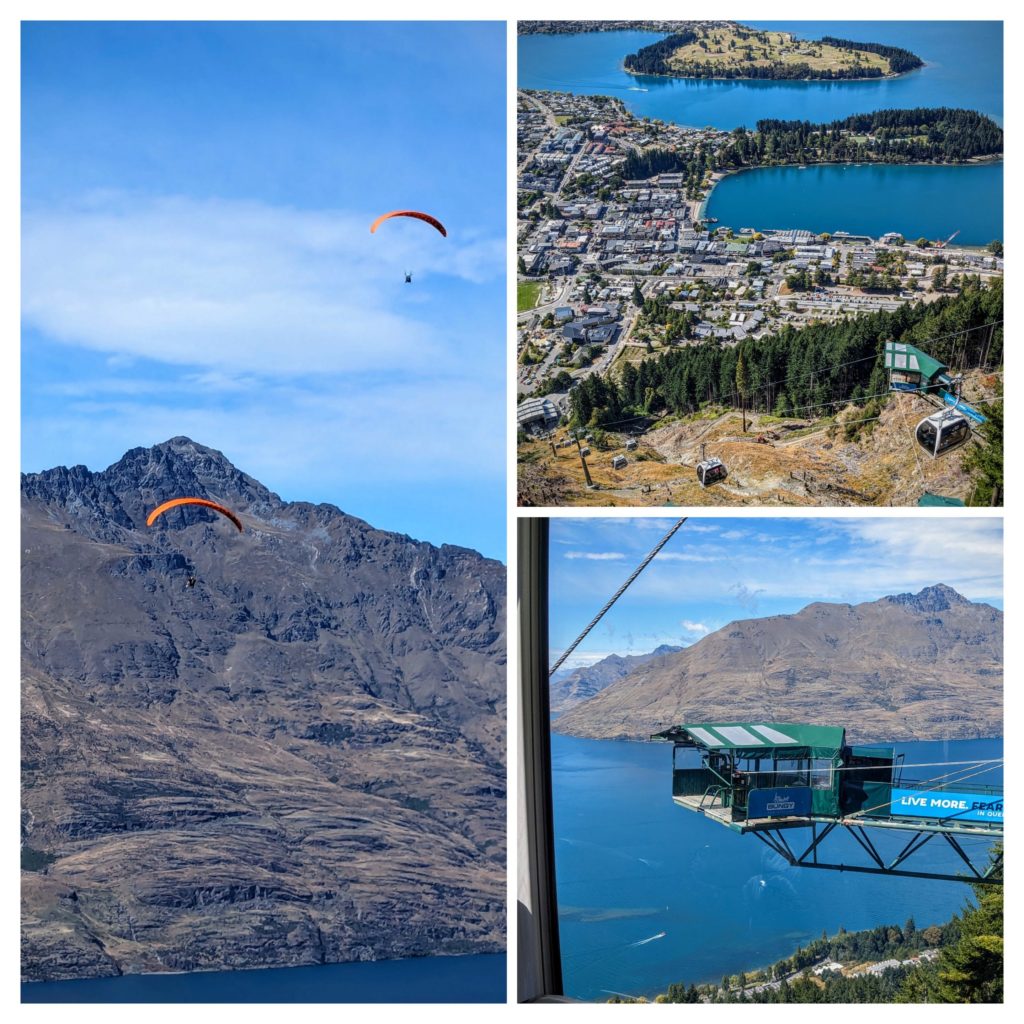
A montage of views; paragliders, town and cable car view, and a bungy jumping platform, not in use because of construction in the area.
After a short walk around town we eventually said our goodbyes, to meet again in Bend, and we took our leave, heading to our next stop in Dunedin while John and Martha are heading to Milford Sound tomorrow. A short way out of Queenstown we stopped at the Kawarau Gorge Suspension Bridge to get a coffee. It turns out that this is the birthplace of Bungy jumping! We stuck around to watch one jumper, then watched on the big screen in the visitors center to see another would-be jumper back away!
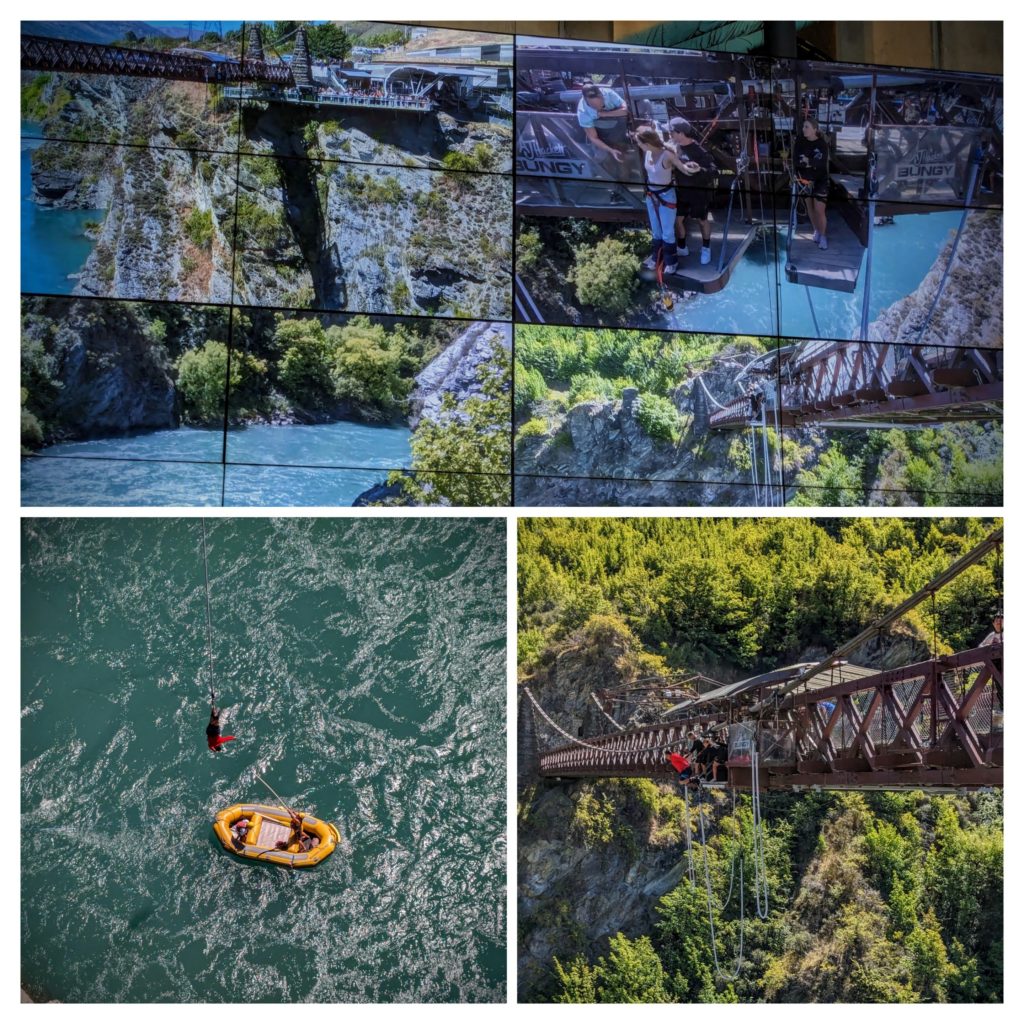
The man in the red t-shirt jumped, or rather stepped (maybe pushed) off the platform. He hung for a few minutes until the boat came for him to grab the pole to be pulled down into the boat and then had to climb a steep staircase to get back to the top! The young lady in the upper right picture decided it was too risky and stepped back from the edge!
We continued on through landscape that reminded us of eastern Oregon and stopped at a park along the Clutha river for a quick nap. Before reaching our Airbnb near Dunedin, above the shore of Otago Harbour.
Before reaching our Airbnb near Dunedin, above the shore of Otago Harbour.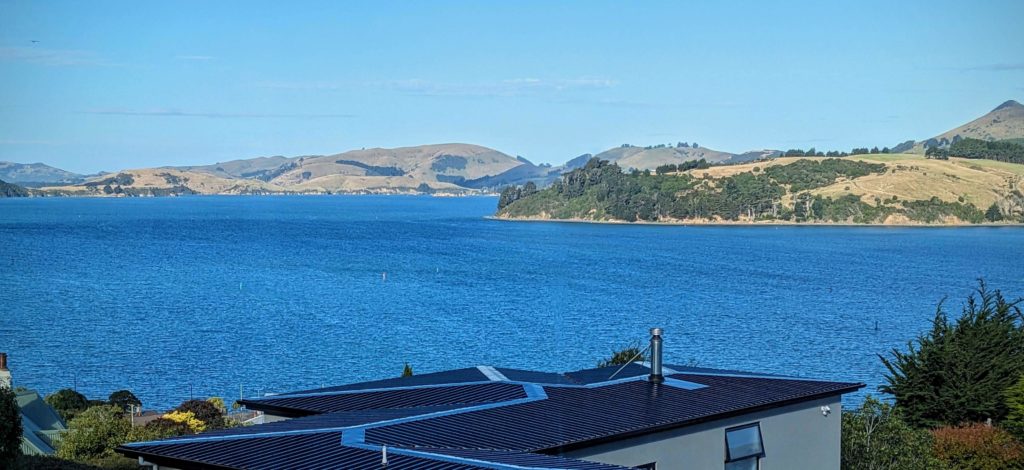
February 11 Move to Qtown (Day 137)
Another moving day, to Queenstown, for a rendezvous with John and Martha who are extending their visit to NZ after their Sydney to Auckland cruise. The day started in Te Anau with rain and clouds and it didn’t start breaking up until we got close to Queenstown.

As the clouds lifted, the mountain tops are revealed with a dusting of snow!
We met John & Martha at their hotel near the airport at about 9:30am, early enough to get into Queenstown proper and find a parking spot! We ended up having to walk uphill to our first stop, Kiwi Park Queenstown, a wildlife sanctuary in the middle of the resort/adventure capital town!
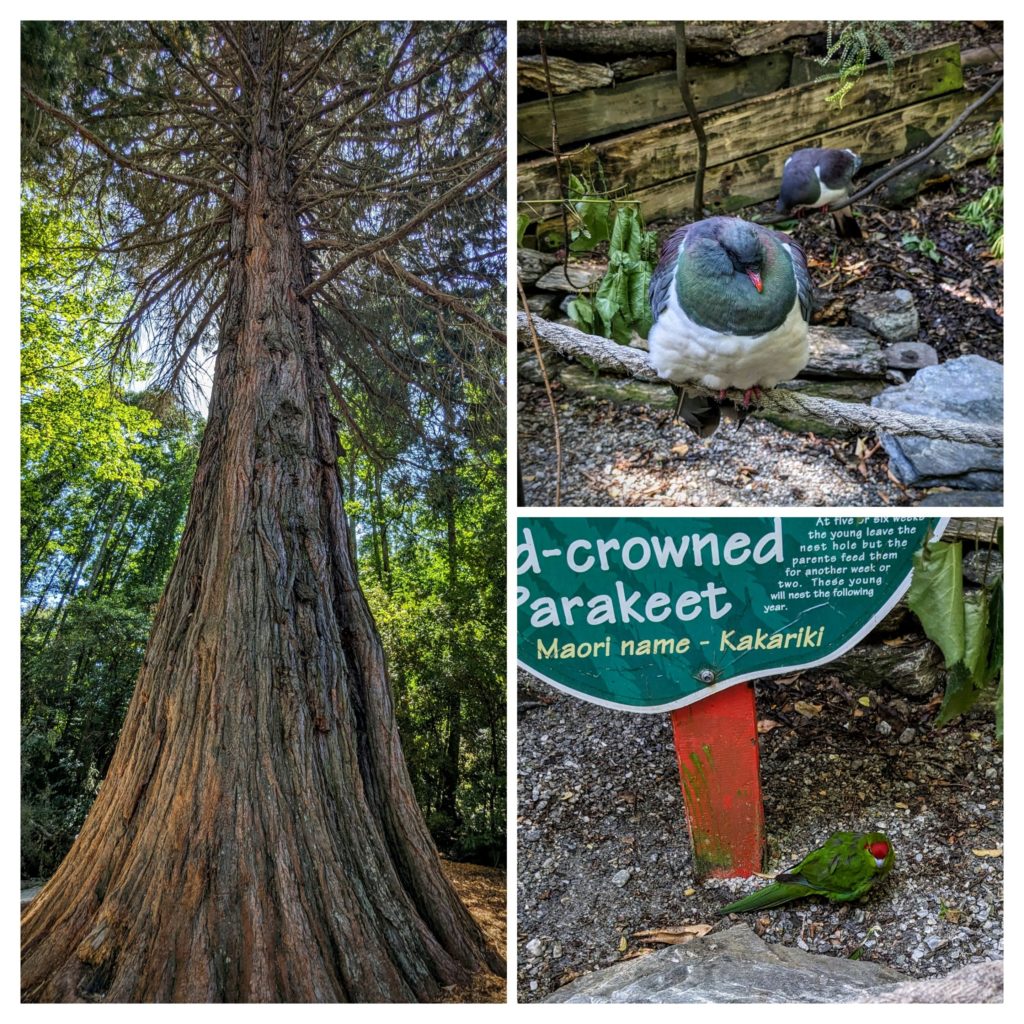
A medley of scenes from Kiwi Park, a huge Sequoia tree, very plump keruru, the NZ wood pigeon, and the red-crowned parakeet, kakariki. Back in December we were in a town called Kakariki on the North Island, named for the parakeet that is no longer found there.
We walked back down the hill and got our lunch at a bakery, the iconic meat pies that we ate out of the paper bags they come in, on a bench on the street, a true Kiwi experience! Walking along the lakefront we had our picture taken by a trio of fellow Americans.

A beautiful day compared to the previous rainy, windy, cold day Robert & I stopped in Queenstown, Jan. 23, for a Fergburger!
We walked through the Queenstown Gardens on a small peninsula extending into Lake Wakatipu with great views of the Remarkables, the mountain range to the southeast.
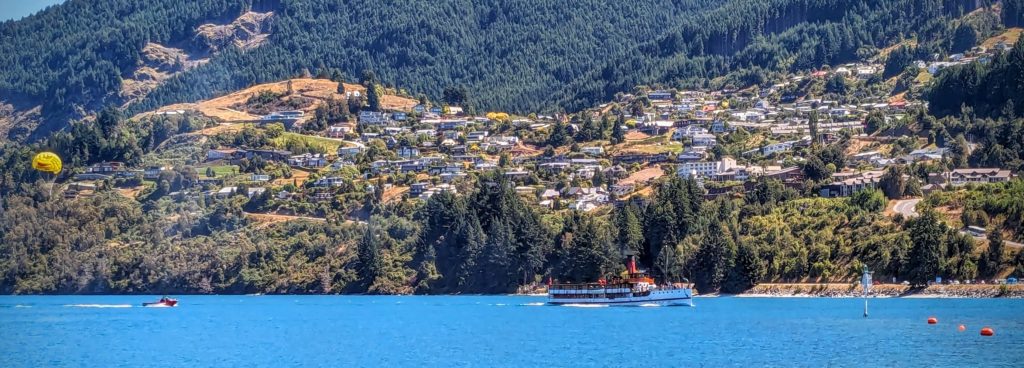
On the lake we saw the steamship TSS Earnslaw, an iconic Queenstown veteran! Following behind is a boat pulling a parasail, another Queenstown adventure!
We finished the afternoon with drinks on Perky’s Floating Bar before Robert & I checked into our hotel and we finished the day with dinner and dessert at a restaurant near our respective hotels.

Dessert; stout beers for John & I!
February 10 Deer Wars (Day 136)
Today is a rainy day, good for packing for our next move. A good time to catch up on posts too. Yesterday after our lakefront hike we got back to the Airbnb and cleaned up to go out for our last night in town. We chose to go to the Black Dog Bar and adjacent Fiordland Cinema.
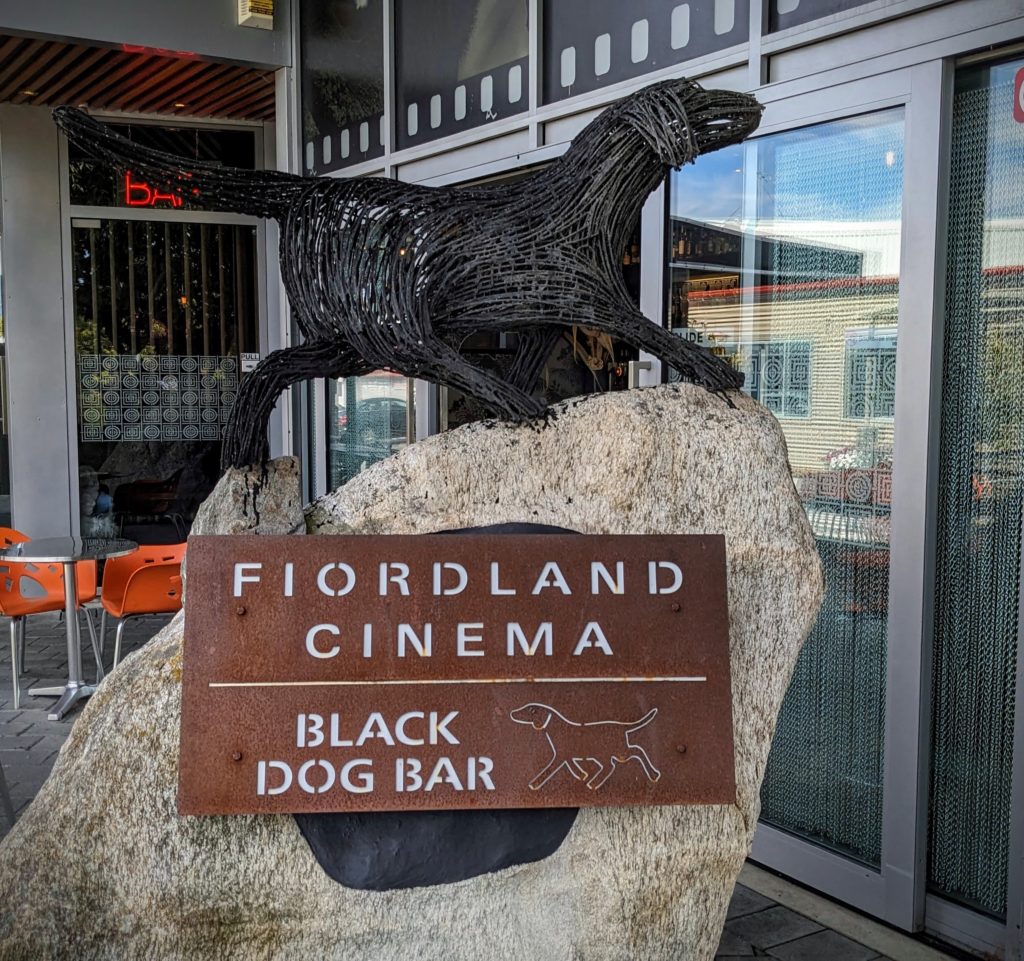
Walking distance from the B&B!
We ordered a cheese and meat plate, and ended up having it for dinner it was so much!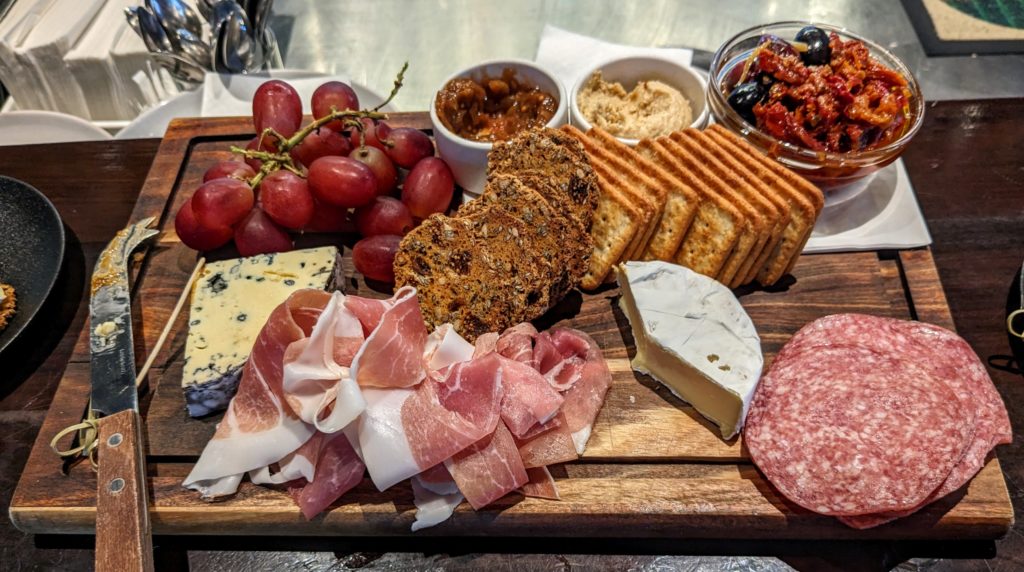
We weren’t able to finish our platter before the movie started. We wanted to see the local production of “Deer Wars”. Our waitress/bartender said that’s okay, you can make a plate to take into the theater with your drinks too! When we settled into our seats (we were the only ones there) she proceeded to the projection room to start the film, woman of many talents!

Cushy, comfortable seats with little tables!
Since we got to Fiordland we have heard about NZ’s ‘Deer Wars’ of the 60’s, 70’s and into the 80’s. Our introduction to the history was on our Doubtful Sound Cruise when the skipper told us about “blokes that bulldogged deer by jumping out of helicopters onto the deer, in the surrounding mountains”. We were incredulous, but he pulled up some video on his laptop to show us. First of all, the mountains here are incredibly steep, secondly, deer in NZ, and in these mountains? Red deer were introduced into NZ in the late 1800’s for sport hunting and quickly overran the country to the point that the government had a cadre of deer cullers after WW2 that instituted the tramping hut system throughout the country. Yet it still was not enough to stop the ecological disaster that the deer wrought. Until…some smart bloke in the 60’s said shoot them from a helicopter!
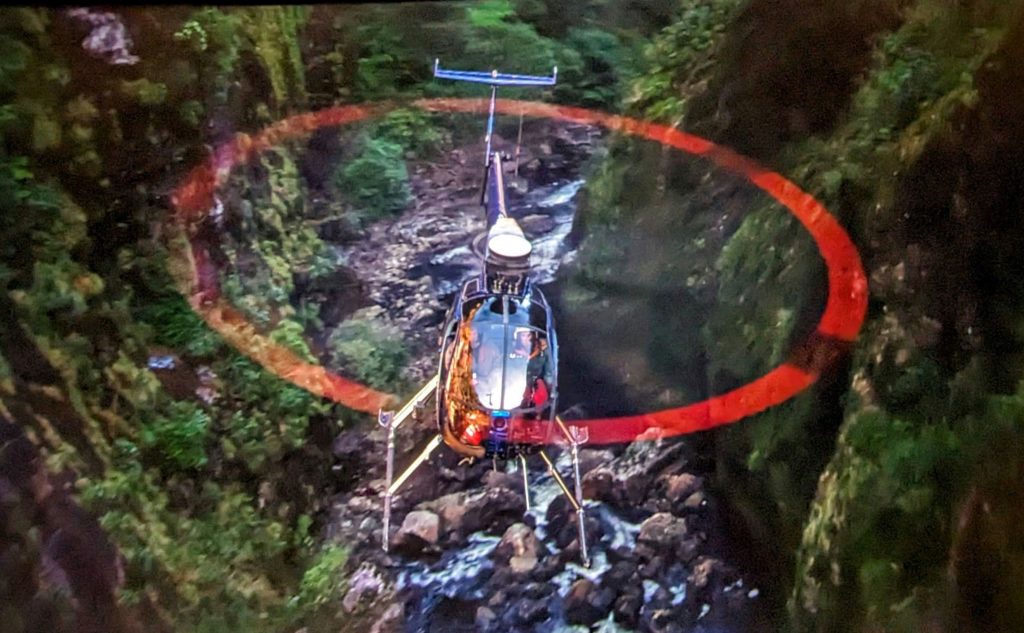
Highly maneuverable helicopters were first used in deer hunting in 1969.
Helicopters were useful especially in the mountains where deer congregated above the tree line. Eventually they decided to take the door off so the shooter has better maneuverability and can jump out, cut the tails off for bounty and jump back on. Then they thought, we’re leaving valuable meat on the mountain, why not use the helicopter to haul the dead deer off the mountain, process it and sell it!
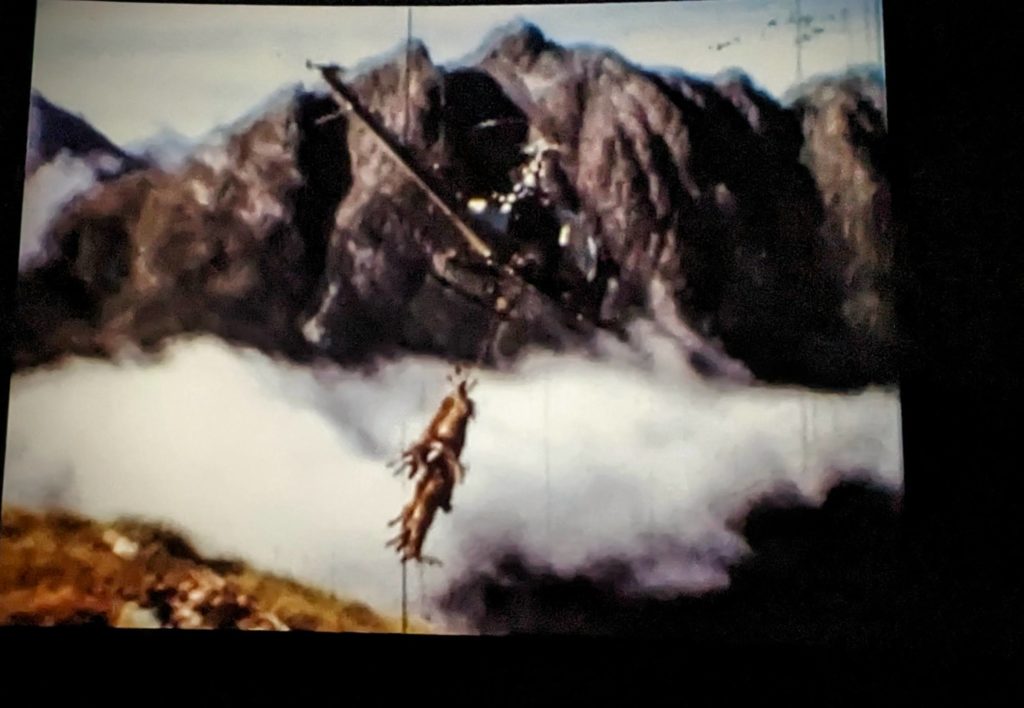
A helicopter hauling the deer carcasses down the mountains.
It was a resounding success with the value of the deer meat soaring. The herds were reduced so much so that poaching ensued and competition spawned fights that eventually the air force was called in to quell. The evolution to the ‘deer farming’ scheme followed; why kill the deer, why not catch them live, bring them to the valley and manage them to create an export resource! Hence the bulldogging, to catch live deer to haul off the mountains!
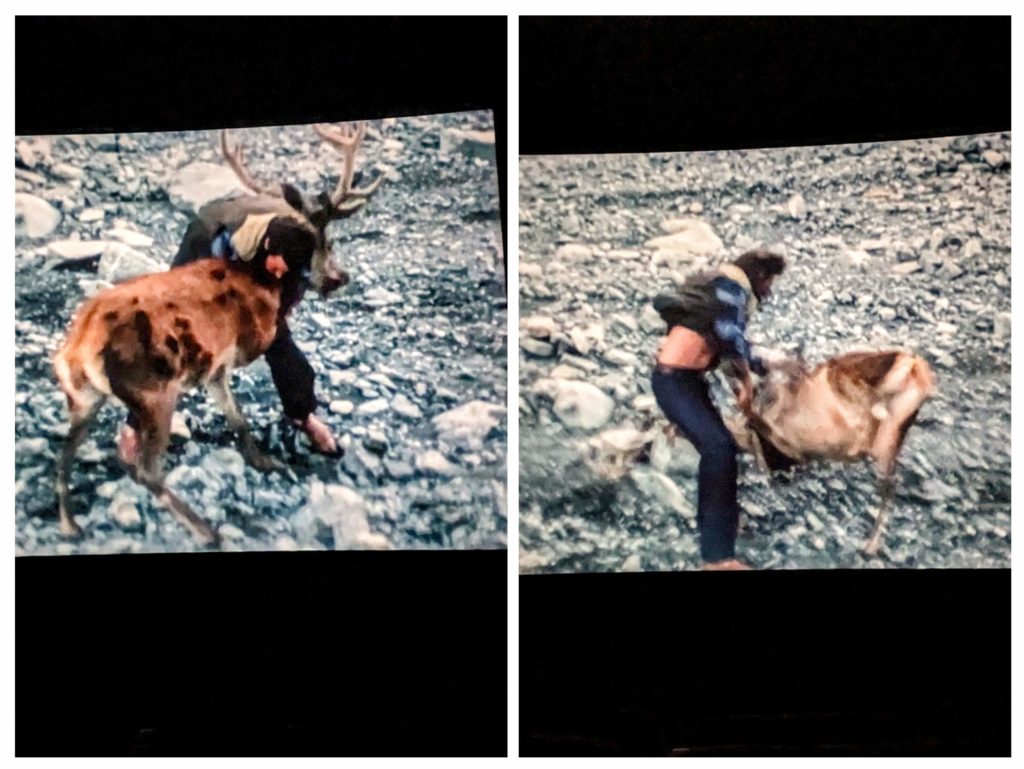
Crazy Kiwi deer bulldogger!
A complete history of the evolution of deer farming in NZ is HERE. The show was so good that we stayed for the next show “Ata Whenua” which was even more fascinating, an aerial (by helicopter) tour of Fiordlands, with a group of Roads Scholars that joined us! On a sidenote, when we boarded the small helicopter for our quick flight to Luxemore hut for our Kepler Track hike, I asked the pilot if he was a veteran of the Deer Wars, he said YES, so I knew we were safe because he survived the Deer Wars! It turns out that the Cinema and Bar were built by Kim Hollows the owner of Fiordland Helicopters and a veteran of the Deer Wars!
February 9 Lake Walk (Day 135)
A beautiful day lay ahead of us so we decided to go for a walk, retracing some of Robert’s walk yesterday. We drove the mile through town to the lakefront and Robert dropped me off at the Bird Sanctuary while he started on the lakefront walk. The star of the Bird Sanctuary is the Takahe, a large chicken sized flightless bird that was thought extinct until 1948 when a small population was found high in the Murchison Mountains across Lake Te Anau! They have been very well protected since and are being raised in captivity at several sites around NZ to be released back to the wild. Check web post Dec. 19, 2023 for a good picture of the Takahe we saw at Zealandia! I couldn’t get a good picture, so here’s one from the reader board.
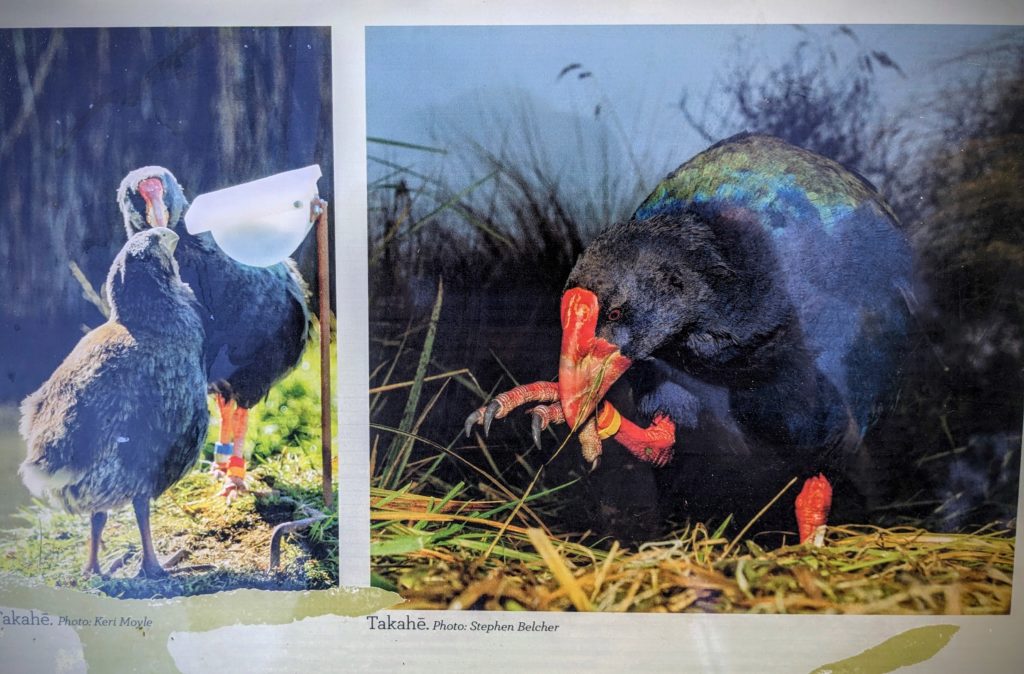
They have several pairs of breeding birds that are kept away from the public.
I finished my tour of the bird sanctuary and started on the lakefront trail to catch Robert at our meeting point. The first half of the trail is on the open, sunny side of the lake, along a golf course. I was able to get a good picture of the NZ Cabbage Tree which we’ve seen throughout the islands. It looks almost like a sturdy yucca, but is no relation.
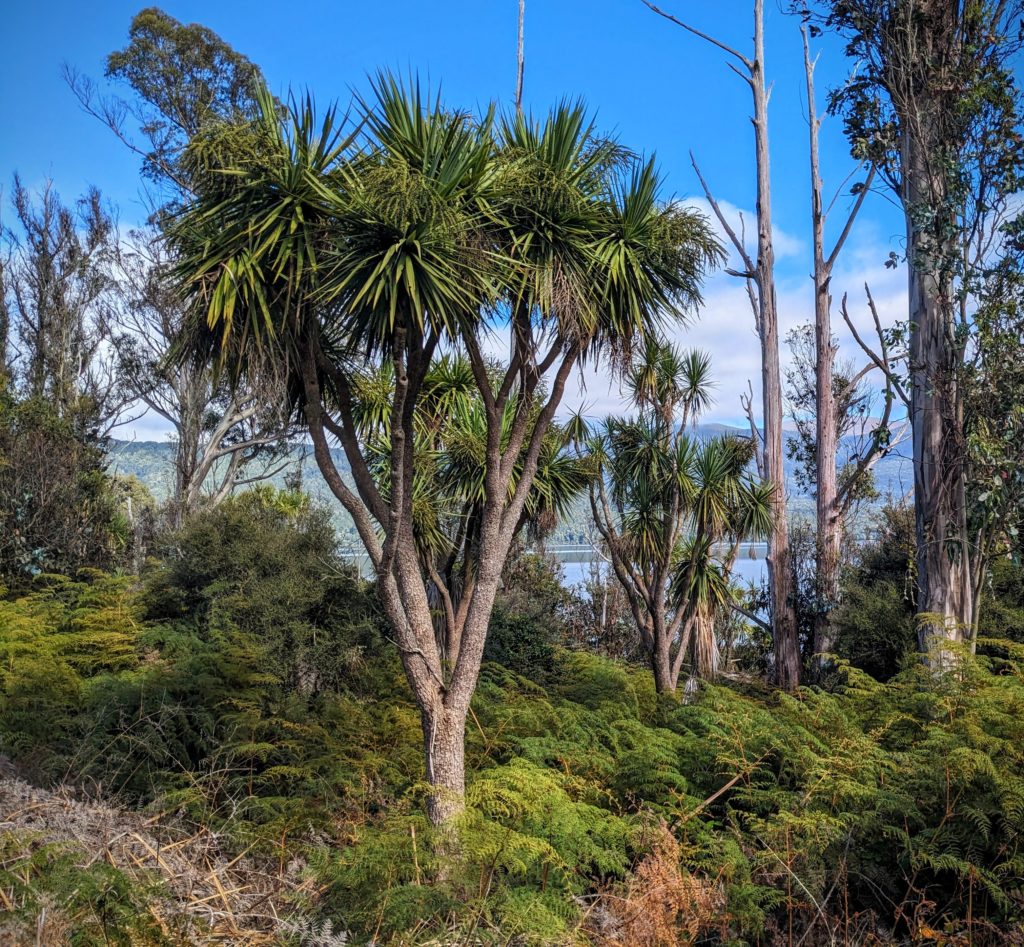
The cabbage tree was an important resource for the Maori and European settlers alike, being used for food, fibre and medicine!
At the dam that controls the outflow of Lake Te Anau into the Waiau river the landscape changes to the beech forest with thick fern undergrowth at the base of the Fiordland mountain ranges. There is another trail, the Lake2Lake Trail, along the Waiau river which connects Lake Te Anau with Lake Manapouri, no time for that trail today though.
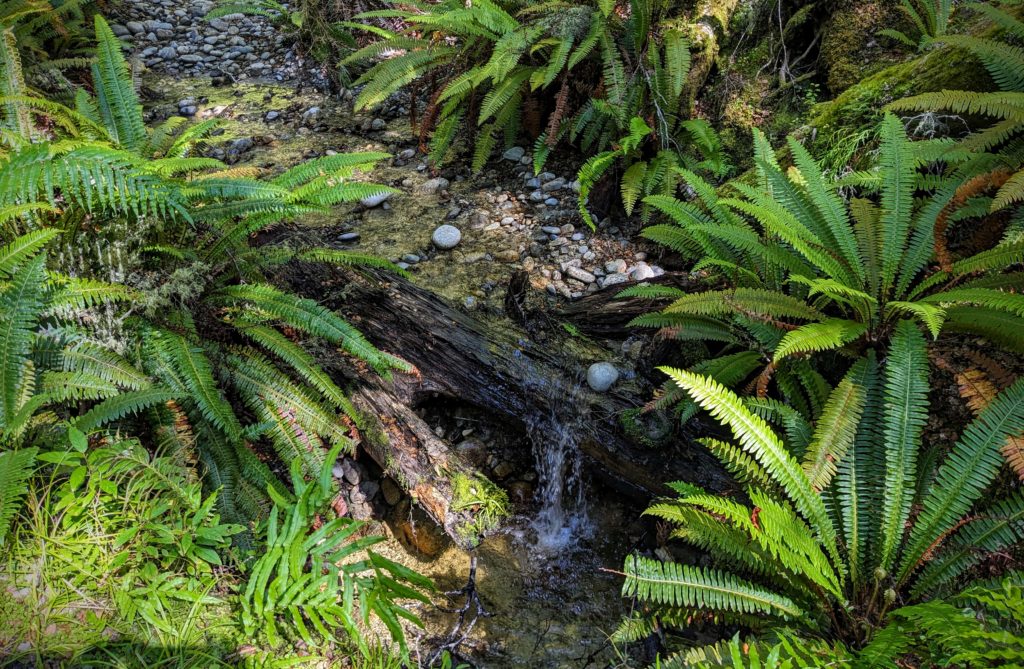
It was nice and cool under the trees, with streams and creeks flowing down out of the mountains into the crystal clear pebbly-bottomed lake.
The trail we were on is the Kepler Trail that we hiked part of just 6 days ago! We met at a picnic area and retraced our hike back to the Bird Sanctuary for a full 7 miles today!

Along the way we enjoyed this view and listened to the melodious song of the Tui bird perched on the top of the dead tree. If you look close enough you might see the white ‘cotton-ball’ feathers on his throat!











 Before reaching our Airbnb near Dunedin, above the shore of Otago Harbour.
Before reaching our Airbnb near Dunedin, above the shore of Otago Harbour.















